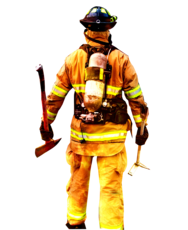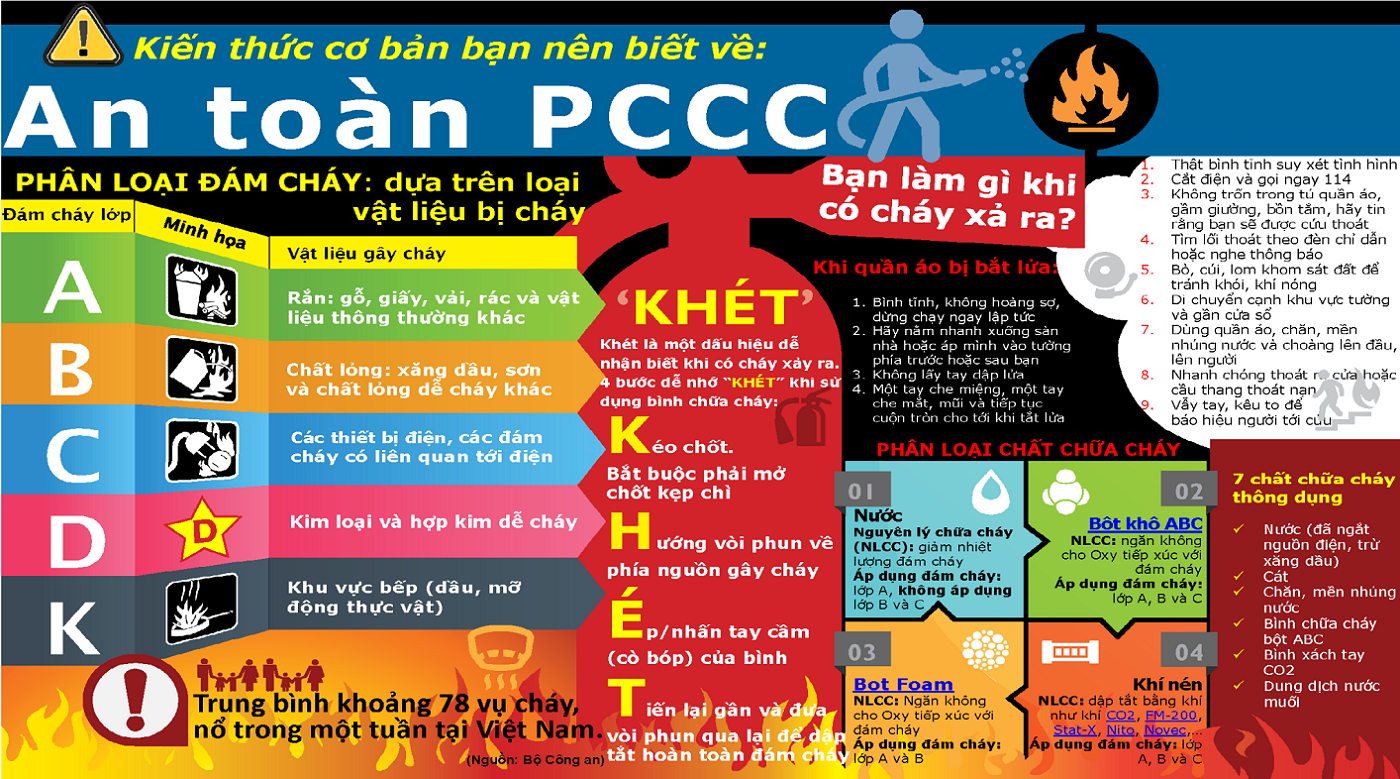Fire safety, at its most basic, is based upon the principleof keeping fuel sources and ignition sources separate.
FIRE EXTINGUISHER TRAINING
PROGRAM
Fire safety, at its most basic, is based upon the principle
of keeping fuel sources and ignition sources separate.
Three things must be present at the same time to produce fire:
1. Enough oxygen to sustain combustion.
2. Enough heat to reach ignition temperature.
3. Some fuel or combustible material.
These three elements form the fire triangle that is necessary for a fire to
burn.
Together, they produce the chemical reaction that is fire. Take away any of
these things and the fire will be extinguished.
FUEL CLASSIFICATIONS
Fires are classified according to the type of fuel that is burning. If you use
the wrong type of extinguisher on the wrong class of fire, you might make
matters worse. It is very important to understand the four different fire (fuel)
classifications:
Class A: Fires in ordinary combustibles, such as wood, cloth, paper,
rubber, and many plastics.
Class B: Fires in flammable or combustible liquids, flammable gasses,
greases, and similar materials.
Class C: Fires in live electrical equipment. When electrical equipment
is deenergized, extinguishers for class A or B fires may be
used.
Class D: Fires in certain combustible metals, such as magnesium,
titanium, zirconium, sodium and potassium. These fires
require Metal-X, foam, and other special extinguishing agents.
Most fire extinguishers will have a label which will tell you which types of
fire the extinguisher is designed to fight.
TYPES OF FIRE EXTINGUISHERS
Different types of fire extinguishers are designed to fight different classes of
fire. The three mostly commonly used extinguishers on the Boston College
Campus are:
1. Water (Pressurized water)
Water extinguishers are large, silver fire extinguishers. They stand
about two feet tall and weigh about 25 pounds when full.
They are filled with ordinary tap water and pressurized air.
How do they work?
Pressurized water extinguishers put out fires by taking the Heat out of
the fire triangle.
When do you use water extinguishers?
They are designed for Class A fires only. Wood, paper, cloth fires are
examples of Class A fires.
Never use a water extinguisher on a flammable liquid fire since it may
cause the fire to spread.
Using water on an Electrical Fire increases the risk of electrocution.
However, it is important to remember that it is only an electrical fire
as long as the appliance is plugged into an electrical source.
2. Carbon Dioxide Extinguishers
Carbon Dioxide fire extinguishers are red. They can range in size
f-rom 5 pounds to 100 pounds or larger. They generally have a horn on
the end of the hose or metal arm which is attached to the cylinder.
When do you use Carbon Dioxide Extinguishers?
Carbon Dioxide extinguishers are designed exclusively for Class Band
C fires only! They will frequently be found in flammable liquid
storage areas, laboratories and mechanical rooms.
How do they work?
Carbon Dioxide is a non-flammable gas that takes away the oxygen
f-rom the fire triangle. Carbon Dioxide is extremely cold when it
comes out of the extinguisher, so it also cools the fuel f-rom the fire
triangle.
A Carbon Dioxide extinguisher may not be very effective in
extinguishing Class A fires because it may not be able to displace
enough oxygen to successfully put the fire out. Class A materials may
also continue to smolder and reignite.
3. Dry Chemical Extinguishers
Dry Chemical extinguishers are red. On campus they range in size
f-rom two and one half pounds to twenty pounds.
ABC extinguishers are filled with a fine, yellow powder. The powder
is mostly composed of monoammonium phosphate. The extinguishers
are pressurized with nitrogen gas as an expellant.
When do you use dry chemical extinguishers?
Dry Chemical extinguishers are multi purpose fire extinguishers and
can be used on Class A, B and C fires. Therefore, they can be used on
paper, wood, cloth, flammable liquids and fires involving energized
electrical equipment.
How do they work?
Dry Chemical extinguishers put out fires by coating the fuel with a
thin layer of chemical dust. This in turn separates the fuel f-rom the
oxygen in the air. The powder also has the ability to interrupt the
chemical chain reaction of a fire. These are the most common
extinguishers found on campus since they are very effective at
extinguishing fire.
On campus you will find ABC extinguishers in kitchens in residence
halls, hallways, in laboratories offices, chemical storage areas
mechanical rooms and even in motor vehicles.
4. K-Class Extinguisher
A K-Class extinguisher contains a wet chemical that is composed of a
Potassium based solution.
When do you use a K-Class Extinguisher?
K-Class extinguishers are used on kitchen fires that involve high
temperature cooking oils.
How do they work?
The K-Class extingui sher has a special nozzle on the end of the
the hose that atomizes the solution and distributes i t over the
hazard area. The solution provides both a cooling effect on the fire as
well as forming a blanket on top of the fire this cuts off the oxygen.
The agent, is disc-harged as a fine spray directly at cooking appliances
which reduces the possibility of splashing the hot grease.
The only place that you will find K-Class fire extinguishers on campus
are in kitchens that have deep fat fryers.
HOW TO USE A FIRE EXTINGUISHER
-It is east to remember how to use a fire extinguisher if you remember the
acronym PASS.
Pull
Aim
Squeeze
Sweep
Pull the pin
This will remove the safety mechanism and allow you to
disc-harge the extinguisher.
Aim at the base of the fire
Make sure that you hit the fuel source of the fire. If you
simply aim at the flames, the extinguishing agent will pass
right through and do no good.
Squeeze the handles
This depresses a button that releases the pressurized
extinguishing agent.
Sweep f-rom side to side until the fire is completely out.
Start using the extinguisher f-rom a safe distance away and
then slowly move forward. Once the fire is out, keep close
watch on the area in case it reignites.
RULES FOR FIGHTING FIRES
Fires are very dangerous and you must be very certain that
you will not endanger yourself or any one else when
attempting to extinguish a fire. For this reason the very first
action that you should take when a fire is discovered is:
1. Assist any person in immediate danger to safety, if
you can without any risk to your own safety.
2. Call 911 or activate the building fire alarm by pulling
a pull station. The fire alarm will then notify the fire
department as well as all other building occupants.
Only after completing the above two items, and if the fire is
small, you may attempt to use an extinguisher to put it out.
However, before attempting to fight the fire, remember the
following items:
¸ Know what is burning. If you don’t know what is
burning, you won’t know the proper extinguisher to
use to put the fire out.
¸ Is the fire spreading rapidly? The only time to use a
fire extinguisher is at the initial stages of the fire. If
the fire is already spreading quickly, it is best to
simply evacuate the building.
¸ Be sure that you are comfortable using a fire
extinguisher. If you are not comfortable using an
extinguisher simply evacuate the building and let the
fire department handle it
¸ Never allow the fire to get between you and the exit.
Always position yourself with an exit or other means
of escape at your back in case the extinguisher
malfunctions, or something unexpected happens. This
will keep you f-rom getting trapped.
FIRE EXTINGUISHER TRAINING QUIZ
1. An example of two Class A fuels would be?
a. Cardboard, newspapers
b. Lamp, hot plate
c. Grease, paint thinner
2. A water extinguisher is safe to use on an electrical
fire?
a. True
b. False
3. The three elements of the fire triangle are:
a. Fuel, oxygen and smoke
b. Oxygen, water and fuel
c. Fuel, a heat source and oxygen
d. Fuel, water and a heat source
4. You should always keep an exit or means of escape at
your back when trying to fight a fire:
a. True
b. False
5. Water will extinguish most flammable liquid fires.
a. True
b. False
6. ABC fire extinguishers extinguish fires by cooling
them down.
a. True
b. False
7. As a general rule it is best to attempt to extinguish a
fire prior to activating the fire alarm.
a. True
b. False
8. Which type of extinguisher has a hard horn on the end
of a hose or a metal arm?
a. Pressurized water
b. K-Class
c. ABC dry chemical
d. Carbon Dioxide
9. Which type of fire extinguisher is the most commonly
found on the campus?
a. Pressurized water
b. Carbon Dioxide
c. ABC dry chemical
d. K-Class
10. Do you know whe-re the nearest fire extinguisher is
located in your work area or residence?
a. Yes
b. No
ANSWERS TO QUIZ
1. a
2. b
3. c
4. a
5. b
6. b
7. b
8. d
9. c
10. a











